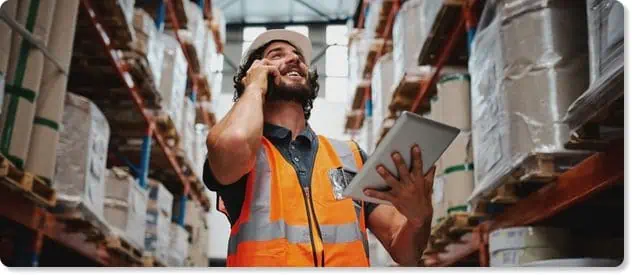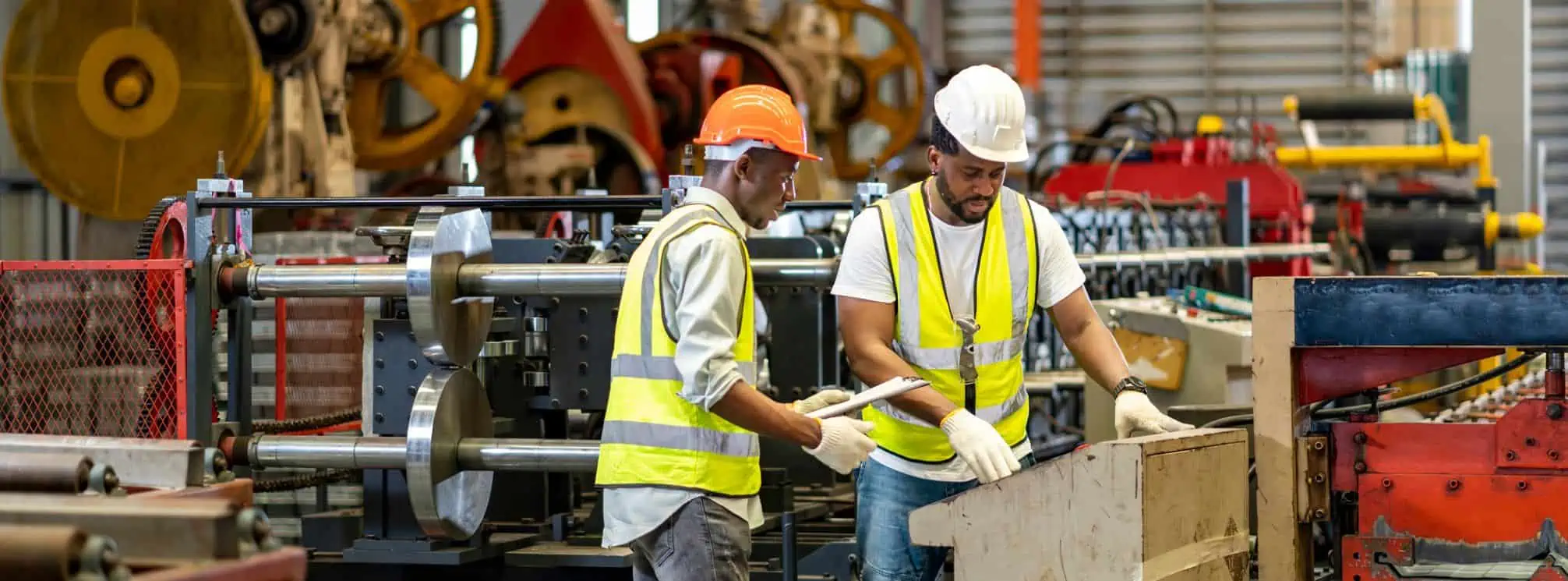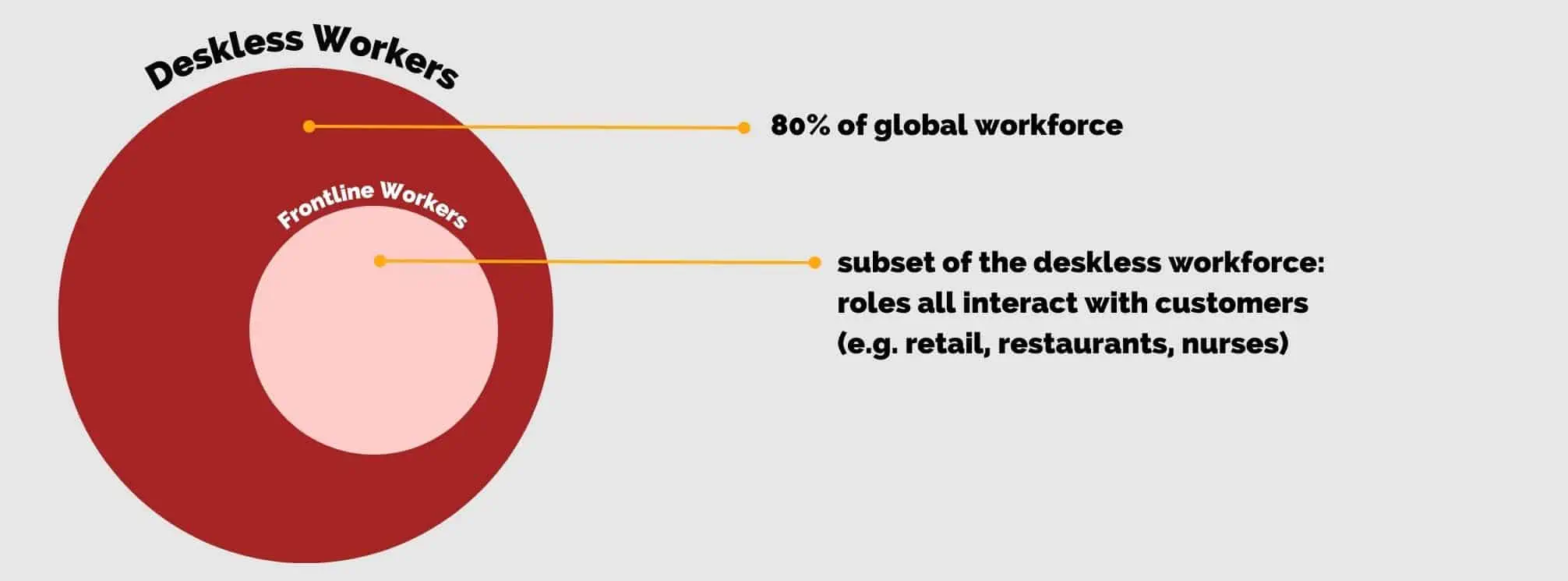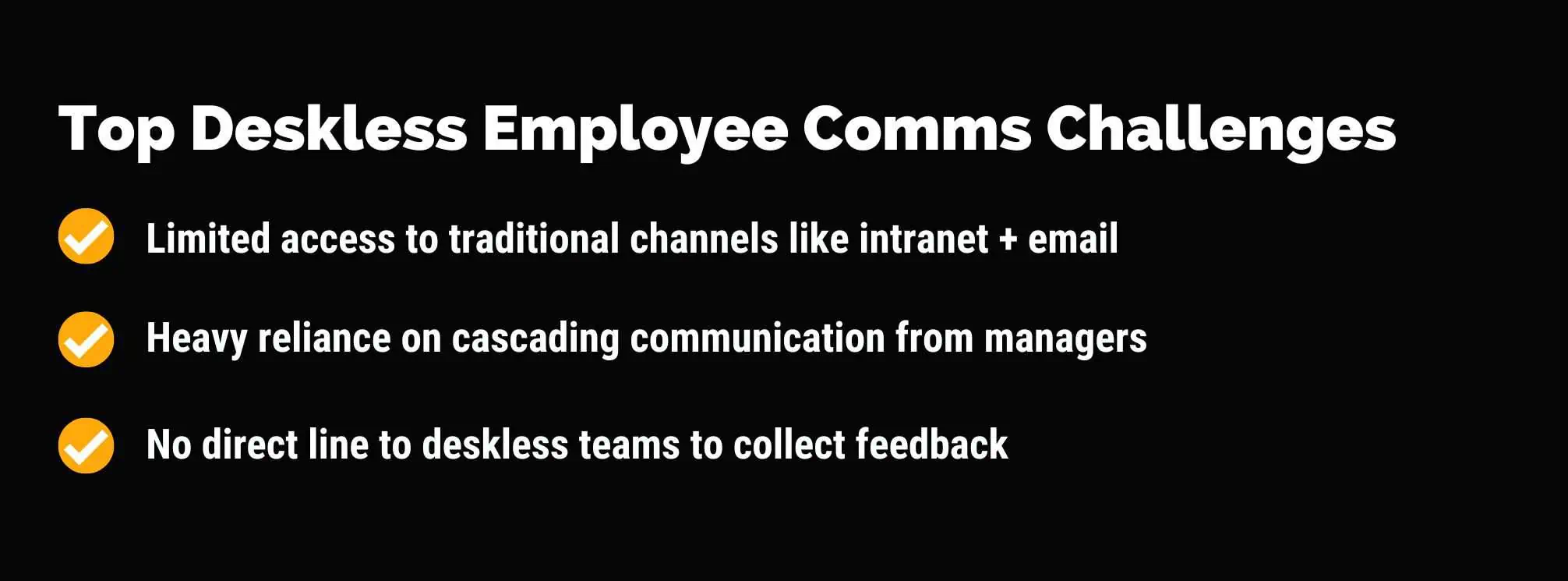Deskless Employees: Who They Are & How to Reach Them
Deskless employees make up the majority of the global workforce. 80% of workers are considered to be deskless, which means they do not sit at a desk for work. Examples of deskless workers include truckers, manufacturing plant workers, and automotive assembly line workers.
Who are deskless employees?
Deskless employees are a vital part of the workforce who primarily work away from traditional office settings and don’t spend their days behind a desk.
These employees might always be on the move (like truck drivers or field technicians) or working on-site in warehouses or manufacturing facilities.
Let’s explore a few examples of deskless workers:
- Construction workers. This group of deskless employees is involved in building our infrastructure, including homes, offices, roads, and bridges. Carpenters, electricians, plumbers, and other skilled tradespeople spend their days at construction sites, working with their tools and materials to bring architectural plans to life.
- Transportation and logistics personnel. Truck drivers and distribution center workers are employees who keep goods and products moving efficiently. They are responsible for transporting goods, ensuring timely deliveries, and managing inventory in warehouses. And they, unlike other transportation workers, often don’t have face-to-face interaction with a customer.
- Manufacturing workers. Employees who work in warehouses or assembly lines are all prime examples of deskless employees.
Deskless teams rely heavily on mobile devices, specialized tools, and communication platforms to stay connected with their colleagues, supervisors, and customers. Though they may not have a dedicated desk, their contributions to the workforce are just as crucial, if not more, in delivering services, satisfying customers, and maintaining productivity.
How are deskless employees different from remote or frontline workers?
While there is a lot of overlap between deskless workers and frontline workers, they aren’t the same. Think of it this way: all frontline workers are deskless, but not all deskless employees are frontline.
The key difference here lies in the nature of their work and the focus of their roles.
Frontline workers are typically associated with industries or sectors that involve direct interaction with the public or are on the frontlines of emergencies or critical situations. They are often involved in providing essential services that directly impact public health, safety, or well-being. Examples of frontline workers include healthcare professionals, emergency responders, and grocery store workers.
Deskless workers, on the other hand, are any employee that doesn’t spend their days at a desk (e.g. remote employees, hybrid workers, or office staff).
What industries have deskless workers?
Deskless workers can come from all industries. But note that these workers are different than remote employees or hybrid workers:
- A real estate agent, for example, may work away from their desk for a portion of the day, but they still use a computer and work out of an office. They are a great example of a hybrid worker.
- Remote workers are really office or deskbound workers. The only distinction here is that they do not have to physically go into a corporate office for their jobs. But they primarily use a computer for their work.
- Therefore, deskless employees are the workers who primarily do their work without a computer. Although some deskless employees might have shared kiosks, computers, or workstations.
Frontline employees are a different type of deskless employee that you can learn more about, but in this guide, we’ll focus on deskless employees who are not front-line. They primarily come from manufacturing, logistics, and back-of-house hospitality (e.g. cleaning staff, chefs and line cooks, etc.).
[optin-monster slug=”fpa9qdcvb2rrfqest1sa” followrules=”true”]
What are the top challenges of communicating with deskless employees?
The main challenges companies have when trying to communicate with deskless employees are:
- Limited access to traditional internal communication channels like email, in-person meetings (town halls), and Intranets.
- Heavy reliance on the cascade of communication, which results in things being lost in translation and the message varying based on the individual manager relaying it.
- No direct line to deskless employees (and vice versa), making it difficult to get employee feedback and include them in employee engagement initiatives that often favor deskbound employees.
As you can see, the biggest barriers come down to the worker’s location, the technology available to them, and our existing systems that are skewed to favor deskbound workers. The 2020 COVID-19 pandemic proved to many organizations how flawed this system was, even as their office staff became remote and lost access to outdated methods of internal communication.
The state of deskless employee communication
We survey deskless employees annually to learn about how they feel about employee communication at their organization. In 2021 and 2022, we have seen a few key trends emerge from that survey.
Managers are more satisfied with internal communication.
There are many reasons why this could be the case. Our survey results show that managers just have more access to channels of communication.
This means:
- Companies should invest in more direct communication channels for all employees, not just those in managerial positions or who work on a computer.
- Because managers have more access to information, we need to focus on training them as communicators to strengthen the cascade of information to our deskless workers.
Younger employees prefer mobile-first communication channels.
Perhaps unsurprisingly, younger employees were more likely to say they wanted texting or employee apps to receive messages.
This means:
- We need to start considering how employee communication has to evolve as young millennials and Gen Z employees become a larger part of the workforce.
- We still need diverse channel mixes to reach all employees the way they prefer.
Younger employees are more concerned with topics like diversity and inclusion.
What we communicate is just as important as how we communicate. While all generations want to see information on topics like benefits and training and development opportunities, age can impact what other subjects matter.
This means:
- We need to continue the best practice of sharing a communication preferences survey regularly.
- Companies should invest the time and resources to create employee personas and update them to keep pace with our rapidly changing audiences.
[optin-monster slug=”liy0awjljxnqdkxbi0ng” followrules=”true”]
Tools for engaging deskless employees
Because engaging deskless employees is a challenge, it’s important to find the right tools to engage and support your deskless workforce.
Here are some of the best tools for engaging deskless workers:
- Mobile communication apps. Utilizing mobile communication apps is crucial for connecting with deskless teams. These apps enable real-time messaging, video calls, and file sharing, allowing for instant communication and collaboration.
- Mobile workforce management tools. Workforce management platforms provide a centralized hub for deskless employee scheduling, task assignment, and tracking. These tools help streamline operations, ensure efficient task allocation, and provide transparency for employees.
- Social intranet platforms. Social intranet platforms create a virtual community for deskless employees to connect, share updates, and collaborate. These platforms facilitate knowledge sharing, company-wide communication, and engagement. Just make sure it’s also a mobile-friendly employee intranet!
- Mobile learning and training platforms. Deskless workers often require specific training and upskilling for their jobs. Mobile learning and training platforms, like microlearning, help to deliver on-the-go training directly on employees’ mobile devices.
It’s important to choose tools that align with the specific needs of your business and the preferences of your people.
Implementing a combination of tools can enhance communication, collaboration, training, recognition, and overall engagement among deskless employees, fostering a more connected and productive workforce.
Ready to learn more?
[optin-monster slug=”ucyxtz2fxemh6aryl4gg” followrules=”true”]




